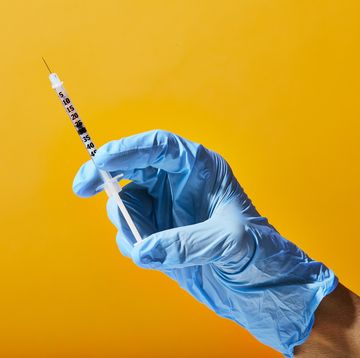Ryan is 29 and single, an outdoorsy New Englander who earns a comfortable living as a consultant in the health care industry. A respected professional with multiple degrees, he played lacrosse in college and still loves the sport. He works out six days a week and, until his health suddenly deteriorated, hadn’t taken a sick day in three years.
But that run of exceptional health ended one morning in early 2012, when he woke up and noticed a stinging sensation when he peed. A few days later, Ryan was pissing fire.
When yellow pus began seeping from the end of his penis, he realized the problem would not disappear on its own.
“I have a very high pain tolerance, and I could keep calm and carry on, but this was definitely,” he searches for a word, “. . .an experience.”
He finally sought help at a clinic he’d discovered as an undergrad, a place he could enter with a degree of anonymity.
Ryan had a textbook case of gonorrhea. But you should note that the textbook is being rewritten by Neisseria gonorrhoeae, a strain of bacteria that causes the second most common of diseases tracked in the United States.
The affliction is probably as old as civilization itself, with references dating back to Chinese medical texts from 2600 B.C. In the 1940s, with the introduction of penicillin, gonorrhea became little more than an inconvenience, a problem easily cleared with a single doctor’s visit.
(For a closer look at the most prevalent STDs and how to prevent them, read our STD Diagnostic Guide.)
Penicillin remained a reliable clap killer until 1976, when the mutating microbe finally gained the upper hand over that go-to antibiotic.
Over the following decades, gonorrhea quickly overpowered each new antibiotic that doctors threw at it.
In 2007, the afflicted could rely on only one class of drugs, called cephalo-sporins.
By 2012, the year Ryan ended up at the health clinic, the CDC recommended switching from an oral form of cephalosporin to an injectable version that would pump higher concentrations into the patient’s bloodstream.
So it was that Ryan received 125 milligrams of the drug ceftriaxone, with a jab in his left butt cheek.
The symptoms vanished. . .but then reappeared with new vigor a couple of months later.
Ryan returned to the clinic. “They couldn’t believe I had it again,” he says. He swore he was not a fan of wanton sex. A nurse practitioner, who was also an acquaintance, assured her colleagues at the clinic that Ryan was a responsible fellow.
He took another shot-a double dose. Again the burning urination and pus-filled discharge subsided.
That is, until the symptoms recurred for a third round.
This time, doctors sent a sample of Ryan’s bug to be analyzed by a lab in an effort to find something that would exterminate it. His bacteria became a public health marvel in the state of Vermont, a kind of uniqueness that Ryan didn’t appreciate.
He knew persistent gonorrhea could leave him sterile and “do all sorts of crazy stuff.” For instance, it could infect the fluid surrounding his spinal cord and brain.
In the end, Ryan was lucky. His infection finally yielded to a titanic 500-milligram dose of ceftriaxone—four times the amount of his original injection—plus a second antibiotic. It left him dizzy and nauseated, but cured.
We live in the era of super-gonorrhea. Drug-resistant gonococci that had been breeding in Asian nations are now spreading to such an extent that the World Health Organization has declared gonorrhea a global concern and warned that without new drugs, infections may one day become untreatable.
“This is clearly a superbug,” says Peter Leone, M.D., an infectious disease specialist and professor of medicine at the University of North Carolina.
He predicts that gonorrhea will eventually conquer the only remaining drugs it now succumbs to, as it has done with all the drugs thrown at it in the past half century.
(You don't have to give up sex entirely to avoid this scary superbug. Find out the 5 Ways to Protect Yourself From Super-Gonorrhea.)
And it’s not just a penis-vagina problem anymore. Now, more cases of gonorrhea are in the throat or rectum, Dr. Leone says. “In those sites, people often don’t have symptoms.” This new development will allow gonorrhea to move silently from person to person with little to slow it down.
The man who infected Ryan never felt so much as a twinge. The two had met at a sports bar in downtown St. Louis about two weeks before Ryan became ill. Both were traveling on business, the man from California.
They struck up a conversation, mostly about their shared passion, lacrosse. While the man had a desk job, Ryan could see the outline of muscle under his dress shirt.
“He was a lot like me in that he took care of himself,” Ryan says. “One thing led to another.”
The flirting ended with a night at the guy’s hotel. While he did use a condom, Ryan admits that he’d had a few drinks, so protection was subject to operator error.
Each year, gonorrhea infects about 107 million people worldwide. In the United States, that translates to an estimated 820,000 new cases annually. The rate has remained relatively flat for about a decade.
(Find out about another Old-School STD That's Making a Comeback.)
What worries public health officials is the upward creep in drug resistance to cephalosporins, and how loss of the final treatment now on the market might redirect transmission.
About 0.1 percent of infections tested in 2008 showed some resistance to ceftriaxone. That figure had quadrupled to 0.4 percent by 2011 but dropped back down after doctors started increasing the amount of drug given for treatment.
If those numbers sound tiny, realize that an antibiotic is usually dropped due to ineffectiveness when the proportion of resistant infections hits 5 percent.
In December, federal officials reported that for the first time in more than a decade, gonorrhea infection rates in men exceeded those of women.
“Men who have sex with men is where we’ve seen the greatest increase and the highest prevalence of resistance. That trend continues. Now we’ve seen an increase in heterosexual men too,” Dr. Leone says. “This organism will move and has moved into the heterosexual population.”
Consider this: Last July, doctors in Sweden writing in the journal Eurosurveillance described the challenges they faced trying to eliminate resistant gonorrhea from the throats of four heterosexual men and women.
In three of them, 500 milligrams of ceftriaxone (the dose that finally cured Ryan) hadn’t so much as budged the infection. Eradication eventually required 1,000 milligrams of the antibiotic.
To combat resistance, U.S. doctors now routinely administer injections of 250 milligrams of ceftriaxone, along with a second antibiotic for seven days as backup.
That strategy appears to be working—for the time being. In the past two years, the percentage of gonorrhea cases with resistance to ceftriaxone has dipped.
(Super-Gonorrhea isn't the only thing you should be worried about. Check out these 3 STDs You May Already Have.)
Still, no one thinks the problem is solved. “We’re hitting gonorrhea with a sledgehammer,” says Jeffrey Klausner, M.D., a public health infectious disease specialist at UCLA, “but we’re running out of sledgehammers.”
Stopping the disease will ultimately require new drugs, but there haven’t been any for more than a decade.
Between 1930 and 1962, about 20 new classes of antimicrobial drugs came on the market. Since then, only two have debuted, the last one appearing in 2003. That’s why a potential new antibiotic received an explosion of media attention this past January, even though it had been tested only in mice.
The economics of drug development favor medicines that people take often and for a long time, like treatments for high cholesterol or arthritis. (Recent legislation has tried to encourage antibiotic development by making the finances more attractive.)
At the same time, unlike drugs for chronic diseases, antimicrobials carry the unfortunate distinction of losing effectiveness as years go by.
Bacteria develop resistance through exposure to doses of antibiotics that don’t wipe out the entire colony. The aftermath leaves behind just the bugs that were able to outmaneuver treatment. Those resistant bacteria can then spread to other people.
Experts also warn that the widespread use of antibiotics in the food industry could foster the development of resistant organisms by exerting a constant, low-level survival pressure on bacteria.
It’s as if we’re putting them in training and helping them build more strength. Since 2012, in order to help preserve the power of cephalosporins, the FDA has banned their use to promote growth of livestock.
Gonorrhea is just one chapter in a larger story of global drug resistance. So many infections are now resistant to treatment that in 2014 an official with the World Health Organization warned that “without urgent, coordinated action by many stakeholders, the world is headed for a post-antibiotic era, in which common infections and minor injuries which have been treatable for decades can once again kill.”
(Could where you live increase your chances of getting infected? Find out about America’s Most STD-Infested States.)
Last fall, the White House launched a battle against resistant infections, calling them “a serious threat to public health and the economy.”
Among the concerns are three resistant organisms the CDC has classified as urgent threats. Two primarily infect people in hospitals. The third, and the only one that largely preys on healthy people, is gonorrhea.
A lot of microbes resist drugs that attack them, but gonococci are notoriously skilled at it.
For instance, a single gonococcal microbe can scavenge genes from its neighbors, splicing the new DNA into its own genome. If another organism, even one of a different species, carries genetic code for a molecule that disables a drug, it can share it with gonococci that were never even exposed to the medicine. (See below.)
Should gonorrhea pick up the means for cephalosporin resistance from another kind of bacteria, it wouldn’t be the first time.
In the 1980s, gonorrhea became resistant to the antibiotic tetracycline by stealing genes from group B strep, a bacterium that causes a sore throat.
Even worse is the fact that gonococci will huddle among the bacterial masses at the back of the throat, giving the organism an entire lending library of helpful genes to choose from.
“It is the ultimate social network,” says Jonathan Zenilman, M.D., chief of infectious diseases at Johns Hopkins Bayview Medical Center in Baltimore.
And because 90 percent of people who have gonorrhea in the throat are completely unaware that they are infected, they have no reason to seek treatment.
(Need more incentive? Check out these Foolproof Ways To Make Sure You ALWAYS Wear a Condom.)
Of the four Swedish patients with highly resistant gono-cocci, only one had a scratchy throat. The other infections were discovered with routine samples. How do you treat a disease no one feels? How do you stop its spread?
Gonorrhea in the pharynx also claims new victims because of the popularity of oral sex, which more than eighty percent of men in their 20s and 30s say they practice. Hardly anybody uses a condom for that. But receive condomless oral from an infected partner, and bacteria from the throat can easily infect the penis.
The King County, Washington, health department is one of the few agencies that regularly screen for throat infections. Lindley Barbee, M.D., M.P.H., says about 10 percent of asymptomatic men who have sex with other men test positive. They don’t feel a thing; their partners might.
Resistant gonorrhea tends to arise in Asia, which is home to both a thriving sex tourism industry and readily available antibiotics.
The initial signs of serious trouble for ceftriaxone appeared in 2007, when Japanese physicians reported the cases of four infected men who’d had sex with prostitutes; each of the men required a then-unheard-of 1,000 milligrams of the drug to be cured.
In 2011, doctors described a gonorrhea strain discovered in the throat of a 31-year-old sex worker in Kyoto who had come in for routine screening. Her infection also required 1,000 milligrams.
In the United States, resistant infections tend to make landfall in Hawaii and states along the West Coast—presumably because they’re closest to the hot zones across the Pacific.
That’s where public health officials are particularly on the lookout for cephalosporin resistance. Still, only a fraction of cases are cultured. “It is a surveillance system that six months after you’ve already got a crisis tells you you’ve got a crisis,” says William Smith, director of the National Coalition of STD Directors.
The use of bacterial cultures has fallen out of favor as clinics adopt quicker diagnostic tests. Those tests can tell you a person has gonorrhea but provide no information about whether the bug is resistant.
As in Ryan’s case, an infection is presumed to be susceptible to standard treatment unless gonorrhea recurs. And even then, it’s often mistaken for a new infection, not a boomerang of the first one.
That means resistant strains could be treated with the same ineffective dose again, adding new generations of superbugs to the spawn as a result.
Smith’s organization has appeared on Capitol Hill asking lawmakers for an additional $53 million in emergency funding to combat the influx; without action, he warns, we may have “another untreatable STD on our hands.”
(Related: 5 Diseases College Students Should Worry About.)
In addition to paying for more surveillance, the money would be used to teach private doctors to make proper diagnoses and increase public awareness. And it would strengthen local health departments, which are straining to meet demand. In 2012, more than half the country’s STD programs lost budget money, and 21 health departments closed their STD clinics altogether.
And clinic doors are slamming shut at a time when hyper-resistant gonorrhea has already popped up in Spain, France, and Australia. There’s no reason to think the rest of the world’s problem won’t soon be ours too.
“We are using the last known, proven antibiotic in the pipeline,” Smith says. “We know that it’s going to develop resistance to the current regimen. It’s just the way this bacteria works.”
As for Ryan, he hasn’t had any problems since his infection, but it’s not something he’s chancing again. He’s been warning his friends not to be lulled into complacency just because a partner seems healthy.
“It’s a superbug,” he says. “I was fortunate.”














